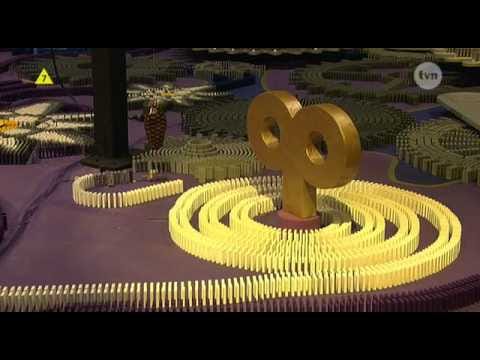Dominoes: The Game and the Art of Toppling Them
Whether playing the game or toppling the game pieces, dominoes make for a fun diversion.
The game of dominoes goes at least all the way back to thirteenth century China. Europe popularized it, in a different form, during the eighteenth century, especially France. Today it’s known and played all over the world.
At one point it became popular to stand domino tiles up and knock them down, not as a game but as an activity. Called “domino toppling” or the “domino effect” or a “chain reaction,” people arrange thousands of them in elaborate patterns, sometimes with devices that help trigger the chain reaction, and watch them fall one by one.
How did that get started?
Memories of playing dominoes
My father was probably the one to teach me the game of dominoes. He taught me checkers, backgammon and various card games, so I feel confident in stating this.
No matter what type of game we played, he never let me win. He was adamant in his belief that I would learn more by losing, so he never took it easy on me when we played. You can imagine how eight-year-old me felt about being unable to beat him no matter how hard I tried.
In New York, I see Spanish people playing dominoes on folding card tables, in parks or on street corners. They tend to look more relaxed than people who play chess. They’re less competitive.
When I toppled dominoes
As for domino toppling, there was a toy I had as a kid called The Incredible Domino Rally. The Mark I edition came out in 1981 from Mego. It contained:
100 multi-colored dominoes (actually tiles shaped like dominoes, without dots) and 38 with pivots, which you could insert into
3 straight track and 2 curved track sections, which helped make the dominoes stand,
2 bridges, and
an “elevator” with 2 slides and a stanchion, plus
a booklet with assembly instructions and suggestions for patterns.
Later editions had more dominoes and additional contraptions designed to make your “rally” cooler.
In my old apartment, the kitchen had the biggest non-carpeted floor. I arranged patterns under the table and chairs. When my mother came home from work, she disliked seeing the dominoes as she opened the door, but I begged her not to step on anything until I had the chance to knock the dominoes down.
I couldn’t explain to you the appeal of arranging these domino rallies. For me, I suppose it involved an interest in building, and in this case, deconstructing. There’s something satisfying about watching the dominoes fall, because making a rally requires patience and a steady hand—to say the least.
One guy in 1975 had that…
Robert Speca, the domino wizard
Public domino toppling is believed to have begun with a guy named Robert Speca. The Pennsylvania native learned about math induction theory in high school. His teacher likened it to a row of falling dominoes (this video explains the concept). Speca bought four boxes of dominoes to test the idea on his own. He became obsessed.
Speca made domino displays for others, which led to local media coverage and eventually, an appearance on The Tonight Show. At the age of eighteen, he set the first of five Guinness World Records for number of dominoes toppled.
After college, Speca went on the road with his displays, making them for various public events around the world. He has made them on TV for David Letterman, Ellen Degeneres, and even Mister Rogers, among others. He has made them for commercials. He has written two books on the subject.
A craze was born. In time, it went worldwide.
Domino Day
Beginning in 1998, a domino competition aired on TV in the Netherlands which took domino toppling to the next level.
Participants in Domino Day attempted to establish a world record for toppling. To that end, the competing teams of builders arranged huge patterns using hundreds of thousands of multi-colored tiles with Rube Goldberg-like mechanisms. They often included tableaux made from the tiles, depicting corporate logos, scenes from stories, pop culture characters, landscapes, and more.
Robin Paul Weijers (AKA “Mr. Domino”) created the event. It was held at the WTC Expo in Leeuwarden. It lasted from 1999-2009, then went on hiatus from 2010-19 due to financial problems. A revival in 2020 was canceled because of COVID. The next competition is scheduled for November 11.
The current record is 4,491,863 dominoes fallen, set on the show in 2009.
Lily Hevesh
Domino toppling has been popularized on YouTube thanks to the videos of a young toppler named Lily Hevesh.
She started her own YouTube channel, filming her domino rallies, at the age of ten. In March of 2013 one of her videos went viral and her career launched.
Her rallies have appeared in commercials, on TV and in movies. She was the subject of a documentary.
She has almost four million subscribers.
Tumbling dominoes is a thing. I never would’ve predicted that lying on my kitchen floor forty years ago.
————————
As an aside related to the current theme of toys and games: the National Toy Hall of Fame just announced its 2023 finalists.
————————
Have you played with dominoes (the game or making rallies)?



